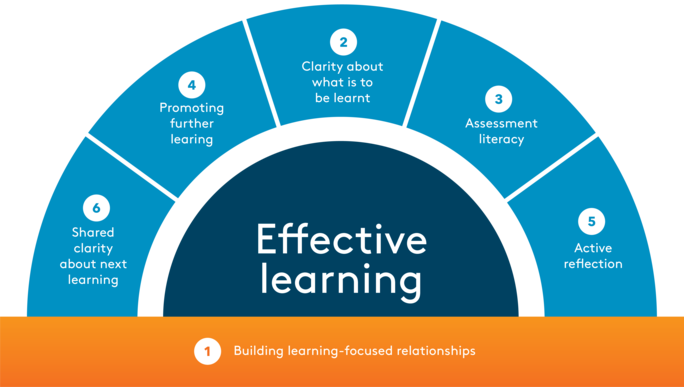Three ways blended learning can enhance active reflection
By Editor on July 13, 2021 in Assessment for learning
As I am new to the Evaluation Associates team, I am drawn almost immediately to Michael Absolum’s touchstone book ‘Clarity in the Classroom’ where the Archway of Teaching and Learning Capabilities is thoroughly explored.
While each capability in the archway is hugely significant in our mahi building the bridge between teaching and learning, I would like to focus on ‘active reflection’ as I believe there is mighty power and potential for this capability to breathe life into the teaching and learning cycles within our schools.
Active reflection skills enable students to take control of their learning, and to be authentically agentic as learners. Teachers who actively reflect with students create genuine partnerships with them to improve learning. In addition, regular, purposeful active reflection can also transform our school-home partnerships by providing clear and transparent communication pathways when a blended learning approach is adopted.

What do we mean by blended learning?
Blended learning, in a nutshell, is using both face to face and online tools responsively to lift learning. It is the merging of physical and digital learning spaces and technologies to personalise learning. Consider a ‘flipped classroom’ where learners are introduced to ‘rewindable’ content at home via an online learning platform (for example, Flipgrid, Canvas, Google Classroom or Microsoft Teams). Students would then engage in practical activities at school with the teacher’s support, or a ‘blended learning rotation’ where the students participate in activities at stations where some are digital and some are paper based.
When blended learning approaches are applied there is transformative potential for connecting the curriculum with experts, communities, whānau, teachers and students.
What do we mean by active reflection?
Active reflection is the process by which learners become aware of their own thinking and, importantly, become capable of identifying what their next steps are. It is in essence ‘metacognition’ or thinking about your thinking!
When learners participate in active reflection, they become capable of assimilating new learning, relating it to their prior knowledge and then adapting and translating it into action. Ultimately, they take can take ownership and become agentic learners who direct their own learning.
Three Ways blended learning can enhance active reflection:
1. Providing transparency
Using digital technologies like Flipgrid, SeeSaw, Linc Ed Hero, Google Apps, Blogs and Microsoft Office tools like Teams or OneNote enables all the stakeholders in the child’s learning to have access to the reflections and empowers participation through commenting or sharing ideas. This means that active reflection process is not bound by time or place, no matter what form it takes (for example, written, audio or video).
2. Promoting Partnership
Active reflection through blended learning approaches affords powerful partnerships. The home-school relationship is strengthened and provides pathways for caregivers to be involved with their child and their child’s kaiako in new ways. It also creates communication avenues for teachers with their students.
3. Propelling Agency
Using blended learning approaches enables ubiquity and learners can think about their thinking anywhere, anytime, with anyone, and record it. This reduces the barrier of time. The locus of control is with the learner, and they can invite others to participate in their active reflection. With this process the students become accountable for acting on feedback and identifying their own next steps. It also enables the learner to curate the active reflection for further future reflection.
Provocation to take away…
While blended approaches can amplify the impact of active reflection and strengthen students’ engagement with their learning, the active reflection process needs to be robust to make a difference for our learners. Therefore, for active reflection to become both embedded and impactful, it is essential that educators are skilled themselves at teaching the students how to reflect effectively. This means that we, as teachers, need to teach our students the skills they require to:
think deeply about their learning
to identify what has been tricky and why
to identify their next learning steps
and to be able to map out what is required to achieve success with those next steps.
Active reflection requires more than the opportunity for reflection (blended or traditional opportunities); it requires skilled teachers to teach students HOW to reflect effectively. Active reflection through blended learning will only make a difference if our learners are taught the skills to think about their learning, identify what has been tricky and why, identify their next steps and how to reach them.
So, in thinking about how blended learning can enhance the active reflection of your students, consider:
Do your students know how to actively reflect on their learning – particularly those who are not experiencing success?
Do teachers in your school know how to teach students to reflect?
Do the teachers in your school know how to use active reflection in a blended environment to ‘power up’ active reflection?
If you’d like to learn more get in touch with Steve and our team today
Other articles you might like
I am the new kid on the block at Evaluation Associates | Te Huinga Kākākura Mātauranga.
A few years ago I visited a school for the first time and a teacher asked what my job was. I told her that I was a facilitator and a lot of my work in schools was supporting teachers and students with assessment for learning. “Ugh… assessment,’ she replied. “If they would just let us get on with teaching!” It was a wonderfully honest response, which demonstrated to me how assessment can start to be viewed as a required task which sits separately to teaching and learning, rather than the bridge between teaching and learning.
There is a strong focus in education on connecting learning between school and home.
